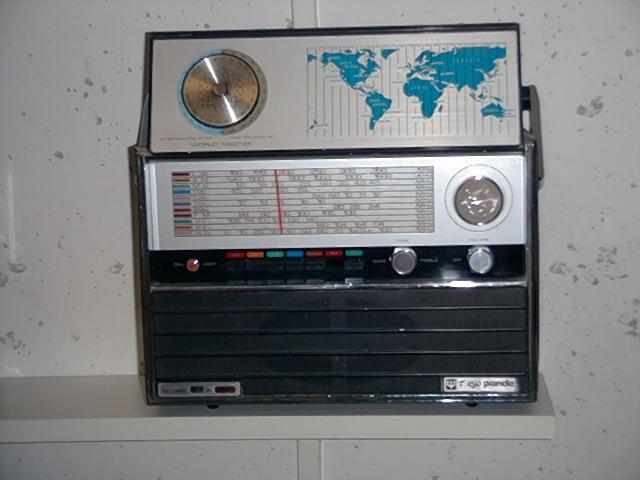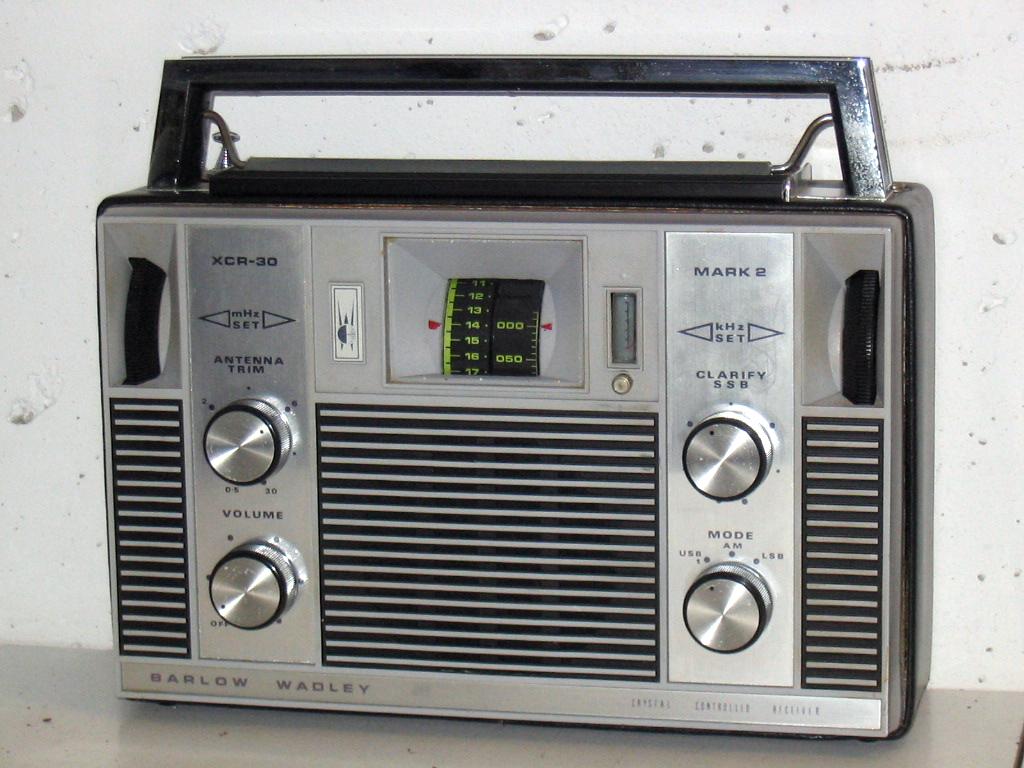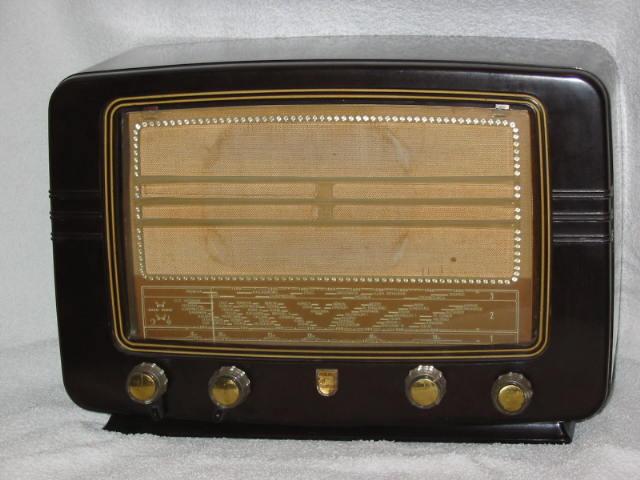
15. De Schaal van Hoen
15. The Hoen Scale
 One day when I visited fellow collector Piet Hoen in his house, we discussed my boatanchor (left) and features that would make a radio useful as a shortwave or communication receiver.
The useability of any radio could be measured by counting the features, and as the overall number of features should be ten, this procedure would rank radios on a scale from 0 to 10 with respect to their communication reception.
In honour of Piet Hoen, who died in September 2000, I call this scale The Hoen Scale or De Schaal van Hoen.
One day when I visited fellow collector Piet Hoen in his house, we discussed my boatanchor (left) and features that would make a radio useful as a shortwave or communication receiver.
The useability of any radio could be measured by counting the features, and as the overall number of features should be ten, this procedure would rank radios on a scale from 0 to 10 with respect to their communication reception.
In honour of Piet Hoen, who died in September 2000, I call this scale The Hoen Scale or De Schaal van Hoen.
The Ten Points
A radio can obtain one point on the scale for the availability of each of the following features, which are useful when the radio is used for Shortwave or Communications DXing.
Note that we count for the availability of the feature, not for its quality: in this way a radio can actually perform better than another with higher ranking.
But it was our goal to classify radio features, not to do a quality comparison.
- A shortwave band with the range 6-16 MHz as often used for broadcast stations.
- Extended shorwave coverage: 2-6 MHz or 16-22 MHz, and this range should be spread over at least four bands to make it useful at all.
- Antennas or antenna jacks other than for the standard longwire antennas.
- RF amplification stage: if the radio has radio-frequent amplification, it also has a tuning circuit before and after that stage, so there will be two radio-frequent tuning circuits. This reduces the reception of unwanted mirror frequencies.
- Fine tuning to allow precise selection of stations.
Especially on higher frequency bands this is absolutely necessary in order to tune.
- Variable bandwidth.
The above features are good for receiving broadcast stations on SW.
To receive other things on shortwave, additional features are necessary.
Most broadcast receivers have IF circuits of fixed bandwidth, optimized for receiving MW stations (bandwidth 9-10kHz).
This may give acceptable results for receiving SW broadcasts (bandwidth 5 kHz), but for Morse or SSB a narrow filter is possible.
A radio for both broadcast and communication should therefore have the ability to choose between narrow and wide IF filtering.
- Dial calibration: it is difficult to find stations on the dial, and to find utility stations it is a must that a number on the dial corresponds precisely to the frequency actually received. Also because sometimes one tunes a frequency at which the transmitter isn't active yet.
- Double conversion.
The IF chosen in a radio is a compromise between mirror rejection (which requires high IF) and filtering (requires low IF).
High-end communication receivers use a first high IF for mirror rejection and a second low IF for filtering.
- Beat Frequency Oscillator: the ability to mix the signal with a carrier allows the reception of CW Morse and Single Side Band stations.
This feature almost always comes with the possibility of manual control of RF amplification.
- S-meter.
Serious users want to keep logs of what they receive, and appreciate a singnal strength indication.
A good magic eye gives half a point here.
Example sets
Most of the radios in my collection are broadcast receivers, and most of these were not especially designed for shortwave listening.
Most broadcast receivers (table tops) will score quite low on the Hoen scale.
 Siemens Debeg:
My only real communications receiver is a 9 1/2 on the scale.
It only gives away half a point because it has a magic eye EM34 instead of a decent meter with numerical indication.
Siemens Debeg:
My only real communications receiver is a 9 1/2 on the scale.
It only gives away half a point because it has a magic eye EM34 instead of a decent meter with numerical indication.
The dial accuracy is obtained through a reference crystal oscillator, giving beeps at every 100 kHz on the dial.
 Marc NR-52F1:
This huge transistor portable has 5 SW bands, whip antenna, 50 Ohm antenna jack, RF amplification, fine tuning (added later), BFO, and an S-meter and thus has a Hoen rating of 7.
Marc NR-52F1:
This huge transistor portable has 5 SW bands, whip antenna, 50 Ohm antenna jack, RF amplification, fine tuning (added later), BFO, and an S-meter and thus has a Hoen rating of 7.
Its main problem is that the quality of the features is not very high, but it looks nice.
It has the inevitable world map and time converter; is this really a desirable feature for SW listeners?
 Yupiteru MVT7100:
Hand scanner, covers 0.1 to 1300 MHz in a single band!
Yet, because of its digital tuning I grant it the point for extended shortwave AND for fine tuning!
The antenna jack can support a whip, but external aerials are also possible.
The bandwidth is more narrow for SSB reception, but the narrow bandwidth cannot be selected for SW, and the bandwidth actually is too wide for SW broadcasts!
But is does switch bandwidth so I have to grant it the point... my first tenner!
Yupiteru MVT7100:
Hand scanner, covers 0.1 to 1300 MHz in a single band!
Yet, because of its digital tuning I grant it the point for extended shortwave AND for fine tuning!
The antenna jack can support a whip, but external aerials are also possible.
The bandwidth is more narrow for SSB reception, but the narrow bandwidth cannot be selected for SW, and the bandwidth actually is too wide for SW broadcasts!
But is does switch bandwidth so I have to grant it the point... my first tenner!
 Tokyo Panda:
Beware of nice looking, blinking radios with world time conversion charts!
This radio is desperately trying to look like a short wave listener's desire, but scores only 1 point on the Hoen scale!
Tokyo Panda:
Beware of nice looking, blinking radios with world time conversion charts!
This radio is desperately trying to look like a short wave listener's desire, but scores only 1 point on the Hoen scale!
 Philips 22RL798:
The radio pretends to be a valuable shortwave radio, but actually just scores enough points to be useable as a broadcast receiver.
No double conversion, no BFO, no RF amplification, and the dial calibration is way off, but it has a real S-meter!
Five Hoen points for this blinky shining machine.
Philips 22RL798:
The radio pretends to be a valuable shortwave radio, but actually just scores enough points to be useable as a broadcast receiver.
No double conversion, no BFO, no RF amplification, and the dial calibration is way off, but it has a real S-meter!
Five Hoen points for this blinky shining machine.
 Barlow Wadley XCR30:
The dream of the semi-professional ShortWave listener in the seventies.
It has the usual and extra shortwave bands, trawler band even, and shortwave is spread over about 28 bands so the first two points are harvested.
It fails the antenna criterion, because it only has a wire connector, but because it performs so well on the built-in whip I give it half a point.
The other criteria are not really a problem (bandwidth is not switchable separately, but switching to SSB reduces the bandwith to 3kHz), so this quality piece is good for 9.5 points as well.
Barlow Wadley XCR30:
The dream of the semi-professional ShortWave listener in the seventies.
It has the usual and extra shortwave bands, trawler band even, and shortwave is spread over about 28 bands so the first two points are harvested.
It fails the antenna criterion, because it only has a wire connector, but because it performs so well on the built-in whip I give it half a point.
The other criteria are not really a problem (bandwidth is not switchable separately, but switching to SSB reduces the bandwith to 3kHz), so this quality piece is good for 9.5 points as well.
With my Siemans a 9.5, a 10 for the Yupiteru, and this other 9.5-set you may wonder which one performs best. Well, for any Shortwave listening activity I would still go for the Siemens! Because it mixes with tubes it isn't easily overloaded and the radio is free of noise and sputter if there are strong adjacent channels.
 Philips BX998A:
This most expensive Philips receiver of the nineteen fifties is a superb radio for listening the broadcast stations of your country.
But what if you want to hear an oversea transmission?
It has shortwave, but not enough bands to classify for the "extended shortwave" point.
It has an RF stage and fine tuning, and the IF bandwidth is regulated by the treble control!
With its EM34 tuning eye it gets to a Hoen 4.5 score.
Philips BX998A:
This most expensive Philips receiver of the nineteen fifties is a superb radio for listening the broadcast stations of your country.
But what if you want to hear an oversea transmission?
It has shortwave, but not enough bands to classify for the "extended shortwave" point.
It has an RF stage and fine tuning, and the IF bandwidth is regulated by the treble control!
With its EM34 tuning eye it gets to a Hoen 4.5 score.
 Philips BX690A:
Around 1950 Philips launched its series of radios for the more demanding Shortwave listener.
This radio is one of the higher-class examples, but there were also the BX591A, the Philips BX505AV, and a few others.
The series is characterized by having four to six shortwave bands.
Philips BX690A:
Around 1950 Philips launched its series of radios for the more demanding Shortwave listener.
This radio is one of the higher-class examples, but there were also the BX591A, the Philips BX505AV, and a few others.
The series is characterized by having four to six shortwave bands.
This type has a magic eye (the others don't), but none of the other features, and scores only 2.5.
 Philips BX321A:
What about the standard radio found in many workers' homes?
These people had shortwave if they were lucky, but that's about it.
One Hoen point for 1950's Joe Sixpack!
Philips BX321A:
What about the standard radio found in many workers' homes?
These people had shortwave if they were lucky, but that's about it.
One Hoen point for 1950's Joe Sixpack!
 Siemens Debeg:
My only real communications receiver is a 9 1/2 on the scale.
It only gives away half a point because it has a magic eye EM34 instead of a decent meter with numerical indication.
Siemens Debeg:
My only real communications receiver is a 9 1/2 on the scale.
It only gives away half a point because it has a magic eye EM34 instead of a decent meter with numerical indication.







